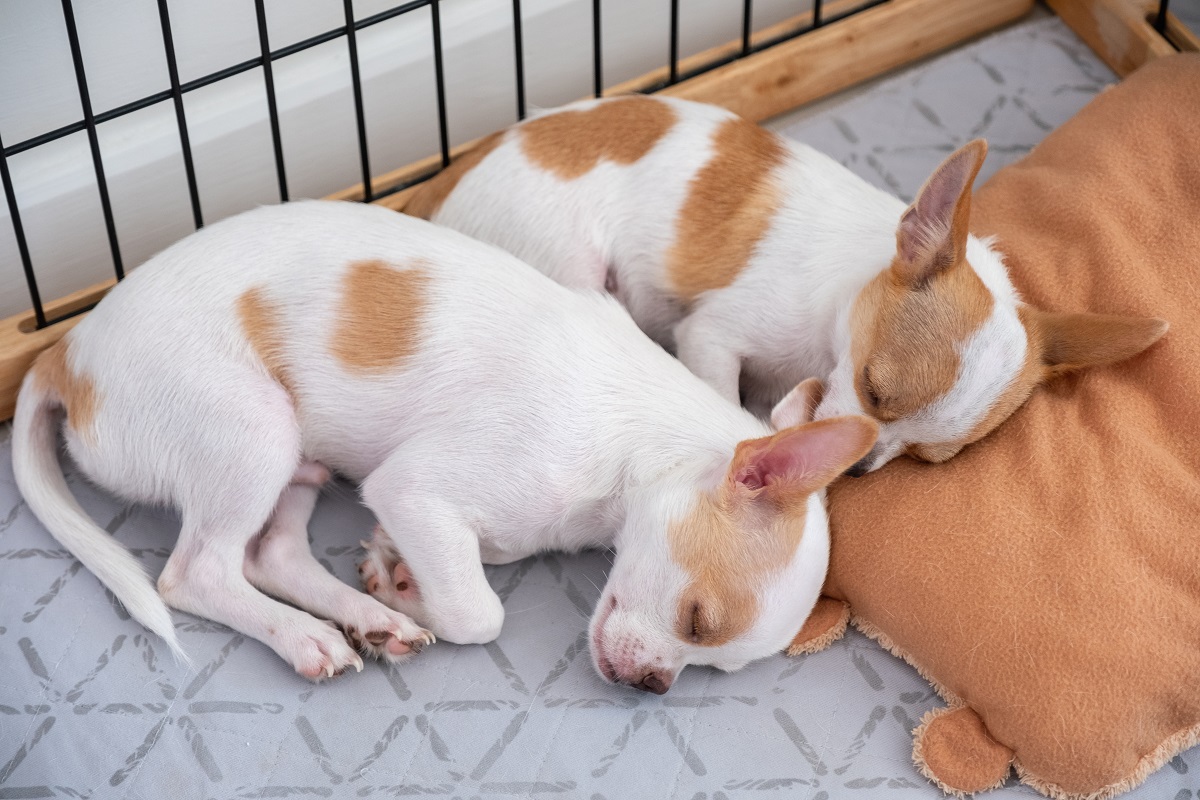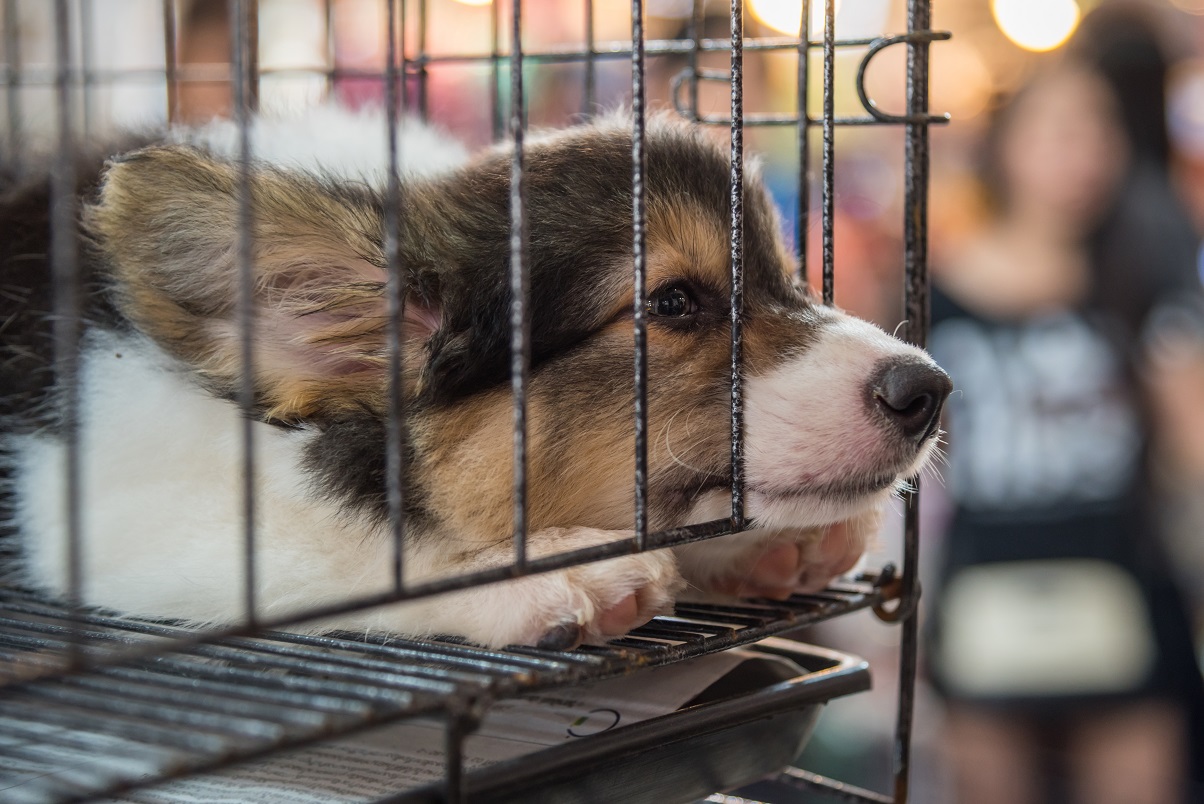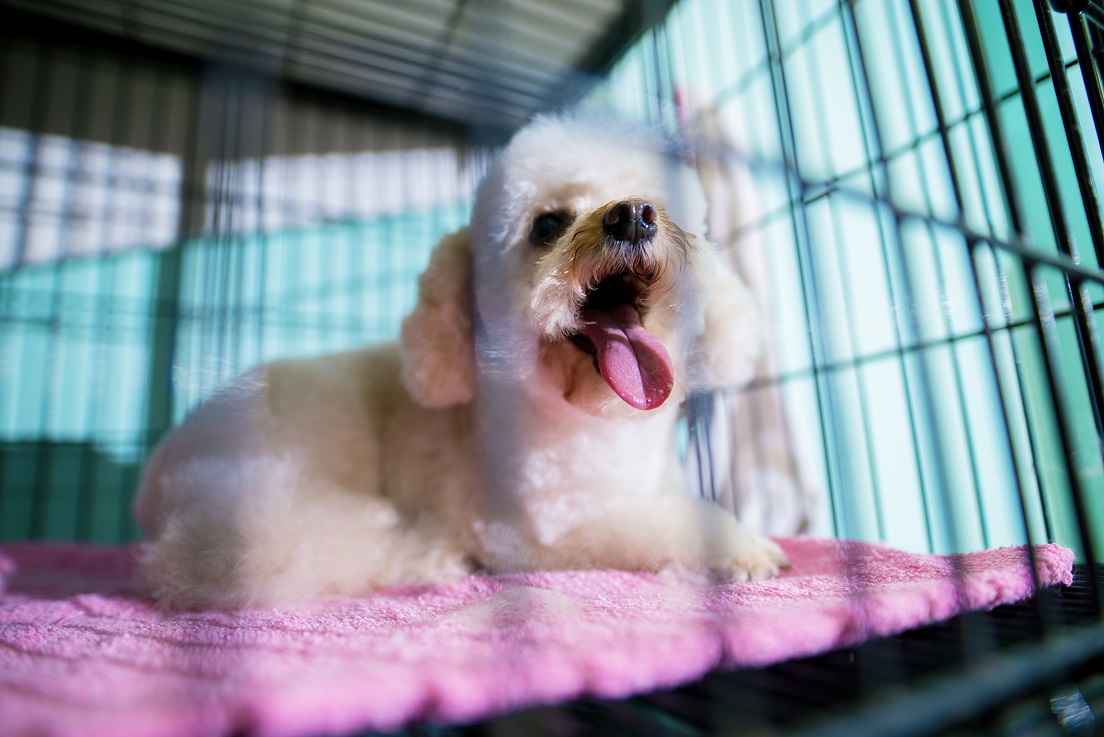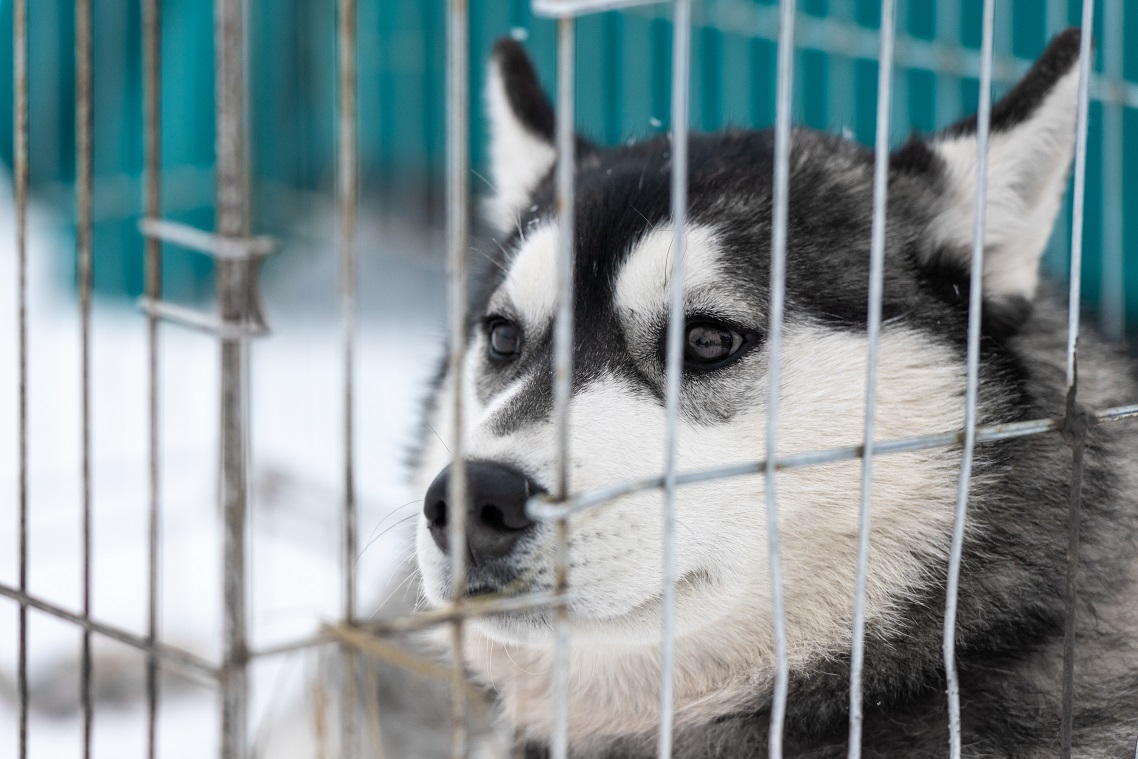How long does it take to crate train a puppy? How long’s a piece of string?
Ultimately, all dogs are different. Some are naturally nervous about anything that’s new or unfamiliar. Others will take to their new crates like ducks to water.
Typically, a few treats, a bit of patience, and a gentle approach will soon have your dog heading to their crate whenever they want some peace and quiet. But don’t despair if that doesn’t happen.
Some dogs are going to take longer. That’s a given. And there’s plenty you can do to encourage them to develop positive associations with the crate (we’ll touch on some of the methods you can use shortly).
But whatever you do, don’t rush a nervous dog. You’ll only end up doing more harm than good.
Even if your pup isn’t the nervous type, you might still encounter some challenges along the way.
From frustration barking to outright crate refusal, crate training can sometimes be fraught with problems. Fortunately, none of those problems are insurmountable.
Providing you go into the process informed and prepared, your puppy will soon learn to adjust and come to love their crate.
Before we start delving into the subject any further, a quick heads-up. Teaching your puppy anything will always be easier when you have a good understanding of what methods and techniques work best.
Whether you’re a first-time puppy owner or an experienced hand looking to brush up on your skills, I’d highly recommended checking out the Puppy Coach Program from Dan Abdelnoor over at The Online Dog Trainer.
The course takes you through everything you need to know about crate training and potty training, giving you a thorough grounding in how to raise a happy, well-adjusted pup. If you want the next few weeks to go smoothly, don’t miss it.
Anyway, here’s the link again to take a look: Puppy Coach Program

Benefits of Crate Training
Crates are divisive.
Some people think that crates are an invaluable aid for potty training and offer a safe sanctuary for their puppy.
Other people think that crates are synonymous with cages, and are loathe to shut their dogs away like prisoners.
Ultimately, the decision is yours.
If you’ve fully convinced that a crate is wrong for both you and your dog, that’s fine. A crate is by no means an absolute essential.
It does, however, offer plenty of benefits that are more than worthy of consideration.
A crate…
Offers a Safe Sanctuary
Adjusting to a new home and a new family can be overwhelming. A crate gives your pup a safe space to retreat to.
Keeps them Safe
We might want to spend 24/7 with our pets, but life has a terrible habit of getting in the way. A crate offers a safe, secure place to keep your puppy when you aren’t around to supervise.
Prevents Undesirable Behaviors
If your pup chews or scratches at furniture when you’re not around to tell them ‘no,’ a crate is the perfect spot to keep them away from trouble.
Provides a Teaching Tool for Kids
Kids don’t always know when a pup is best left in peace. A crate is a clear boundary for kids to know when a puppy needs to sleep or rest rather than play.
Helps with Housetraining
Pups hate soiling the area where they sleep. Used in the right way, a crate is a perfect complement to an effective potty-training routine.
Prepares Dogs for the Future
If a puppy learns to use a crate from a young age, they’re less likely to kick up a fuss if they ever need to use one during travel or before and after surgery.
Related Post: The Definitive Guide To Crate Training A New Puppy

How Long Does It Take To Crate Train A Puppy
Crate training a puppy isn’t that complicated.
Most dogs react well to their new sleeping and resting quarters. Providing they’re introduced to the crate in the right way, most pups will learn in just a few weeks. Others may only take a couple of days.
But ultimately, all dogs are different. Like us, they learn at different paces.
Depending on your pup’s age, temperament, prior experiences, and general attitude towards training, it could take several months before they’re comfortable with their crate.
The first day you start crate training, you’re not going to know for sure whether your dog will be happily sleeping in their crate by the evening. Or if it’s going to take a few months for them to reach that point.
To avoid frustration, it’s best to go into the process with the worst-case scenario in mind. If your pup is one of those that respond well to crate training, you’re in for a pleasant surprise.
If they aren’t… well, at least you’re prepared.
Consistency and patience are key. Crate training, like all other forms of training, can be a great bonding experience for you and your pup.
To get the most out of the experience, go into it with an open mind and a commitment to stand by your dog for just as long as it takes.

Top Tips for Crate Training Your Puppy
Crates offer a myriad of benefits. They can be a sanctuary for your pup, a safe place for them to retreat to, and an effective aid to potty training.
But all of this is dependent on one thing… You.
If you don’t introduce the crate to your pup in the right way, if you rush things or forget to cover the basics, you’re going to face an uphill struggle with your training endeavors.
Before you start, get to grips with the right and wrong way to crate train.
Actually, scratch that.
Get to grips with the right and wrong way to train your puppy, period. After all, crate training isn’t the only thing you’ll be working on over the next few months.
Remember that Puppy Coach Program I mentioned earlier? This is where it really comes in handy.
Take some time to work through the tips and advice in the course. If you get the basics in place now, you’ll reap the rewards down the line.
In the meantime, here are some top crate training tips to put you on the right track.
Set Yourself Up for Success
The first step in effective crate training? Choose the right crate.
The crate should be big enough for your puppy to turn around in, stretch out, and stand up in, but not so big as to encourage them to use a corner of it as their toilet.
Once you bring the crate home, set it up in a comfortable, quiet part of the house.
As puppies can be sensitive to temperature, avoid putting it in a drafty, cold area or directly in front of heat sources.
Make it as cozy and comfortable as possible. Line it with blankets (ideally, make these water and chew-proof) and add a good selection of chew toys and soft toys for your pup to play with.
Entice Them with Treats
Crate training a puppy with no previous experience of being in a crate is fairly simple. A few hours spread over 2 or 3 days might be all that’s needed.
But here’s the rub: try and rush those hours, and you could end up doing more harm than good.
Let your puppy set the pace. Bundling them into the crate and shutting the door behind them on the first attempt is a big no-no.
Start by feeding them their meals in the crate to encourage positive associations. Next, toss a few treats into the front of the crate while your puppy is watching.
When they poke their head through to reach the treats, throw a few further back to encourage them in.
Once they’re safely inside, pass treats through the bars to encourage them to stay.
As a final step, put a tasty bone or an extra special treat inside the crate and shut the door. Wait for your pup to scratch or whine at the door before letting them in. Close the door after them.
Once they’ve finished their treat, open the door to let them out. Repeat the same process over the next few days.
Pretty soon, your pup should be actively seeking out their crate.
Related Post: How To Plan An Effective Crate Training Schedule For A Puppy

Take Baby Steps with Fearful Pups
If your dog has a nervous disposition or has had any prior poor experiences of crates, prepare for the long haul.
Depending on the puppy and their level of fear, it could take several months before you start making headway.
Whatever you do, don’t try to rush them. If you push your puppy beyond a pace they’re comfortable with, it’ll just take longer.
Don’t consider shutting the door to the crate before they’re ready. It may even be helpful to remove the door completely until your dog is completely comfortable.
Start by feeding your puppy their meals at the edge of the crate. Place the bowl just inside the crate, close enough to the door so your puppy doesn’t have to enter the crate to eat.
For some puppies, even this might be too much. If that’s the case, position the bowl directly outside the crate.
Once they’re eating happily by the crate, throw some ultra-tasty treats inside to encourage them in.
Soon, they should be going in and out of the crate without hesitation. Encourage the length of time they spend inside by hand-feeding treats through the bars.
Once they’ve lost all trepidation, place a bone or their favorite snack inside the crate, shut the door, and wait for them to ask to be let in. Let them in, then shut the door for as long as it takes them to finish the treat.
Gradually work on increasing the length of time your puppy spends inside the crate. If they start to become nervous, dial things back. Remember, the crate should be a safe place for your dog.
Avoid Common Mistakes
While crate training is relatively simple, it pays to be aware of some of the common pitfalls and mistakes people can sometimes make.
Firstly, don’t run to let your puppy out of the crate the moment they start to whine. If you respond to your puppy each time they cry, they’ll never stop.
If there’s a chance they need to go to the toilet, take them out so they can do their business. Once they’ve finished, return them to their crate.
If they cry again, ignore it. It may sound harsh, but if you let your puppy out each time they whine, you’re never going to get anywhere with their training.
That being said, it’s important to recognize the difference between a puppy who’s whining out of frustration and one who’s whining out of fear.
A frustrated puppy will whine and bark for a while, play for a few minutes, then start barking again.
A scared puppy will bark continually, shake, and may even drool.
If your puppy is fear-barking, get them out of the crate straight away. Leaving them to cry will simply lead to them seeing the crate as a source of anxiety.
Finally, don’t leave your puppy in the crate for huge lengths of time from the very beginning.
Keep the initial sessions short and sweet. As their bladder control develops, you can gradually work on increasing the length of time you leave them.
Schedule Potty Breaks
Before you settle your puppy down in their crate for the night, take them for a bathroom break first.
Puppies are naturally disinclined to soil their sleeping area, but that doesn’t mean they won’t if they’re left with no other choice.
Be sure that they’re good and empty before going to bed. Likewise, take them out before you leave them in the crate for any length of time during the day.
Once they’re completely empty, they should be able to ‘hold it’ for the amount of time that corresponds to their age in months, plus one.
Don’t be tempted to exceed this.
It’s also worth bearing in mind that all puppies progress at different rates. Everything from breed to age, temperament to size can play a part in just how long your puppy can hold out before needing to go.

Final Thoughts
Crates can be an invaluable tool. They can be a safe sanctuary for your pup, a secure place to keep them from harm, and a great aid for potty training.
But for a crate to work as it’s intended, you need to introduce it to your puppy in the right way. You also need to be prepared for the long haul.
Ultimately, all puppies are different. Some get used to their crate in a matter of days. Some may need months.
If you try and rush the process, you might inadvertently create negative associations with the crate. If that happens, the training could drag on for even longer.
So be patient. This is one case where slow and steady really does win the race.
